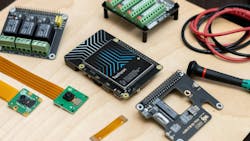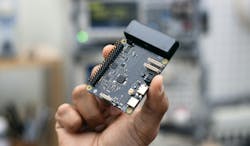Tachyon SBC Embeds Intelligence for AIoT Applications
What you’ll learn:
- Insight into Particle’s Tachyon single board computer (SBC).
- Tachyon’s hardware features.
- Potential applications for the Tachyon SBC.
Particle, a provider of integrated IoT Platform-as-a-Service, launched its latest 5G-capable AI-accelerated single-board computer (SBC) designed for Artificial Intelligence of Things (AIoT) applications. Known as Tachyon, the board takes all of the hardware from modern smartphones, couples it with a Qualcomm AI hardware accelerator, and packs it onto a PCB the size of a credit card to drive portable and remote computing devices. As Particle stated, the SBC can “embed intelligence into anything, anywhere.”
Tachyon has a familiar layout that’s nearly identical to the Raspberry Pi 5, only it packs a more powerful SoC over the Pi’s Broadcom BCM2712. It also features the same 40-pin GPIO header and can even take advantage of Raspberry Pi HAT add-on boards for increased functionality.
The HATs can include a terminal block HAT for automating relays (Fig. 1), a PCIe M.2 HAT for increased storage and peripheral add-ons, sensor HATs for monitoring everything from temperatures and moisture, and more. With that in mind, let’s take a look at what the Tachyon has to offer.
Tachyon’s Hardware Features
The Tachyon (Fig. 2) is driven by a Qualcomm QCS6490 octa-core SoC and offers support for 5G cellular and Wi-Fi 6 connectivity, suiting it for embedded and remote applications. It also features integrated MIPI DSI and CSI display and camera interfaces, a pair of USB-C ports (one with DisplayPort Alt mode), and an additional 20-pin PCIe FFC for PCIe add-ons.
The hardware breakdown is as follows:
- SoC: Qualcomm QCS6490 with octa-core Kryo 670 with 1x Gold Plus core (Cortex-A78), 3x Gold cores (Cortex-A78), and 4x Silver cores (Cortex-A55).
- GPU: Adreno 643L GPU with Open GL ES 3.2, Open CL 2.0, Vulkan 1.x, and DX FL 12 support.
- AI accelerator: Qualcomm AI Engine integrating the Compute Hexagon DSP with dual Hexagon Vector, Hexagon Co-processor 2.0, and Hexagon Tensor accelerator, producing up to 12 TOPS.
- Memory/storage: 4 GB of RAM and 64 GB of built-in UFS storage.
- Interfaces: 1x DisplayPort via USB-C, 4-lane MIPI DSI connector, 2x 4-lane MIPI CSI connectors, and 2x USB 3.1 Type-C ports.
- Connectivity: 5G cellular, Bluetooth 5.2, and Wi-Fi 6E with integrated antennas.
- Expansion: 40-pin GPIO header and 20-pin PCIe connector.
According to Particle, the Tachyon will ship with Ubuntu 24.04. However, the board is expected to support Yocto for those who require customization options. Of course, the board will also support Qualcomm Linux, Android 13, and Windows 11.
The Tachyon is Particle’s solution to the rise in demand for AI-enabled edge platforms that are being utilized in nearly every industry. Devices that come equipped with AI graphics accelerators and wireless connectivity are in high demand, and the board is an ideal platform to integrate the power of AI in everything from embedded to automated systems.
Potential Applications for the Tachyon SBC
“Any engineer or technically minded person should have access to the building blocks of a modern smartphone, but that's not the case right now,” said Zach Supalla, founder and CEO of Particle. “5G connectivity and AI accelerators are limited today because they’re not democratized; only a few large players have access to the bleeding-edge technology that will power the next wave of connected devices. Exploration is the beginning of the innovation cycle, and we want Tachyon to enable that spark of imagination to take root.”
Particle recently launched the Tachyon on Kickstarter, where it surpassed its target funding goal of $10,000 with over $120,000 so far in the campaign. Pledges start at $149 for the “Early Bird” reward level, which is certainly higher than the Raspberry Pi 5. Still, the processing power alone feels justified at that price point, even up to the $219 price for latecomers.
Particle expects to start shipping the Tachyon in January 2025. It should be noted that while the company has successfully funded and shipped its previous AI boards at the stated time, crowdfunding projects aren’t a guarantee that buyers will receive a finished product.
About the Author
Cabe Atwell
Technology Editor, Electronic Design
Cabe is a Technology Editor for Electronic Design.
Engineer, Machinist, Maker, Writer. A graduate Electrical Engineer actively plying his expertise in the industry and at his company, Gunhead. When not designing/building, he creates a steady torrent of projects and content in the media world. Many of his projects and articles are online at element14 & SolidSmack, industry-focused work at EETimes & EDN, and offbeat articles at Make Magazine. Currently, you can find him hosting webinars and contributing to Electronic Design and Machine Design.
Cabe is an electrical engineer, design consultant and author with 25 years’ experience. His most recent book is “Essential 555 IC: Design, Configure, and Create Clever Circuits”
Cabe writes the Engineering on Friday blog on Electronic Design.



